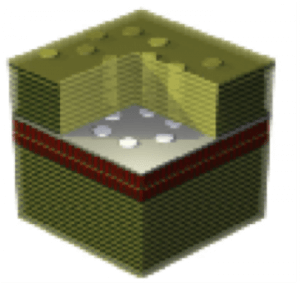Summary
In this project, we build a solid-state quantum simulator for engineering a specific Hamiltonian. Quantum simulators are purpose-built devices with little to no need for error correction, thereby making this type of hardware less demanding than universal quantum computers. Our platform consists of exciton-polariton condensates in multiple quantum-wells sandwiched in a semiconductor Bragg stack onto which a two-dimensional lattice was imprinted. The lattice imprinting can be achieved, for example, by partial etching of the spacer with the lattice pattern followed by an overgrowth of the upper layers of the Bragg structure.
We are particularly interested in exciton-polariton condensates in a kagome lattice, where we can identify topological properties as a function of particle density. A standard optical technique allows us to quantify wavefunctions of exciton-polaritons. To do this, we construct an interferometer for measurement and use power-dependent photoluminescence to identify quantum phases in the kagome lattice.
Our goal is to advance the measurement of topological parameters and knowledge of condensed matter physics in engineered exciton-polariton simulators. This will serve to elucidate quantum phases in a controlled manner and bring us closer to a quantum simulator capable of delivering meaningful insights into quantum materials and optimization.

Figure 1. (top) A hexagonal lattice of micro-cavities formed in a Bragg stack structure with a spacer (white layer) sandwiching multiple quantum wells (red layers). (bottom) Bandstructures of exciton-polaritons in a two-dimensional kagome lattice. As the pump power changes, exciton-polaritons undergo phase transition to form coherent states: below threshold (a) P/Pth ~ 0.04, near threshold (b) P/Pth ~ 1, and above threshold (c) P/Pth ~ 2, where Pth is the threshold pump power.
Related Content

Harnessing the Promise of Quantum Materials for Future Electronic Devices
Summary Two-dimensional (2D) quantum materials, such as graphene and molybdenum disulfide, have great potential for use in future flexible and wearable electronics applications. With traditional silicon-based electronics nearing their theoretical performance limits, nano-electronics made from 2D quantum materials offer breakthrough opportunities for energy-efficient, wearable ubiquitous computation. In this project, we will study integration of […]
June 14, 2018

On-Chip Microwave-Optical Quantum Interface
Summary In this project we develop a quantum interface between microwave and optical photons as a key enabling technology of a hybrid quantum network. In such a network, the robust optical photons carry quantum information through optical fibres over long distances, while superconducting microwave circuits protected from thermal photon noise by the low temperature […]
October 29, 2018
Line-Scanning optical coherence tomography system for in-vivo, non-invasive imaging of the cellular structure and blood perfusion of biological tissue
Summary Optical coherence tomography (OCT) is an optical imaging method that allows for in-vivo, non-invasive imaging of the structure and vasculature of biological tissue. Commercially available, clinical OCT systems utilize point-scanning method to acquire volumetric images over a large surface with typical frame rates of ~ 30 frames/ second. Since living biological tissue is constantly […]
August 27, 2019

Spin Generation and High-Frequency Detection via the Quantum Nonlinear Anomalous Hall Effect in Weyl Semimetals
In magnetic conductors, the passage of current yields an electric field in the transverse direction even without an external magnetic field – this is known as the anomalous Hall effect (AHE). This effect can act as a convenient probe of spin ordering, magnetic textures, spin-orbit coupling, and band topology in solids, and can be further […]
April 19, 2023


